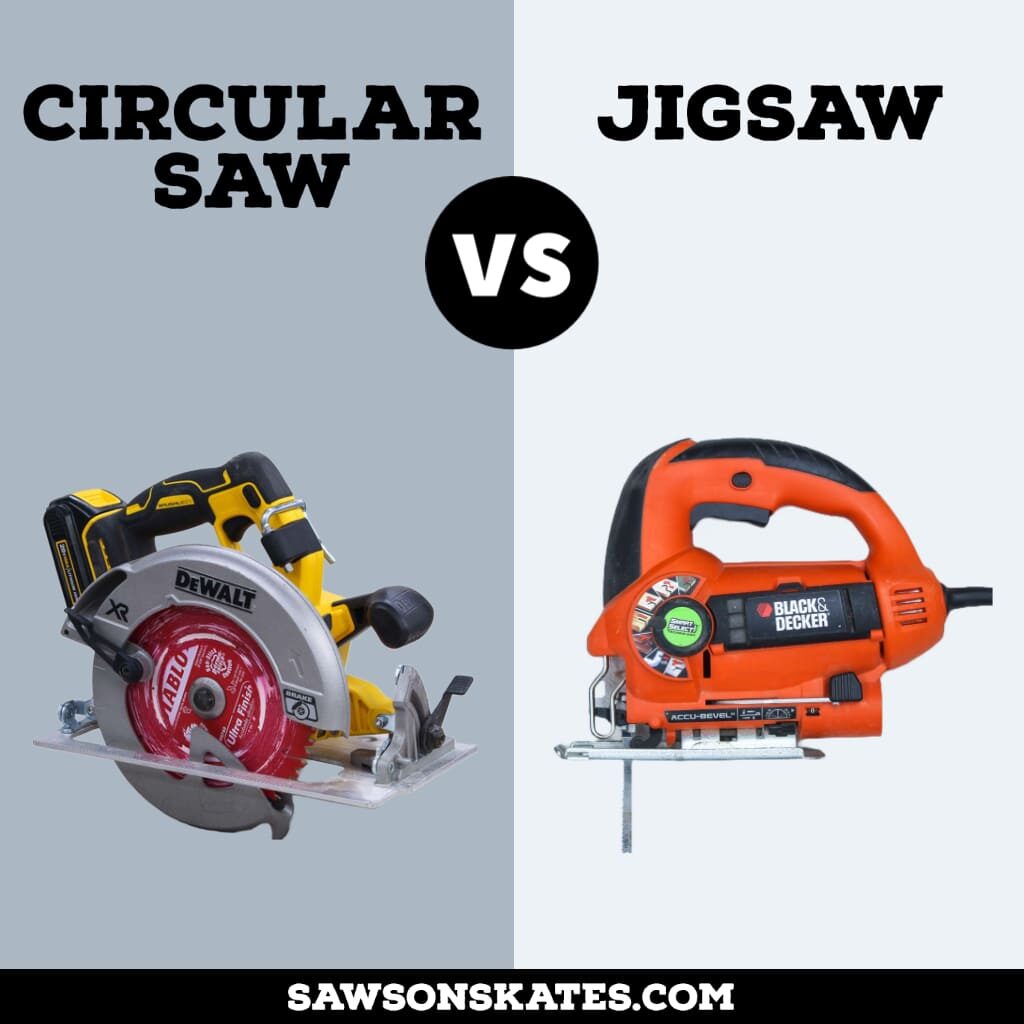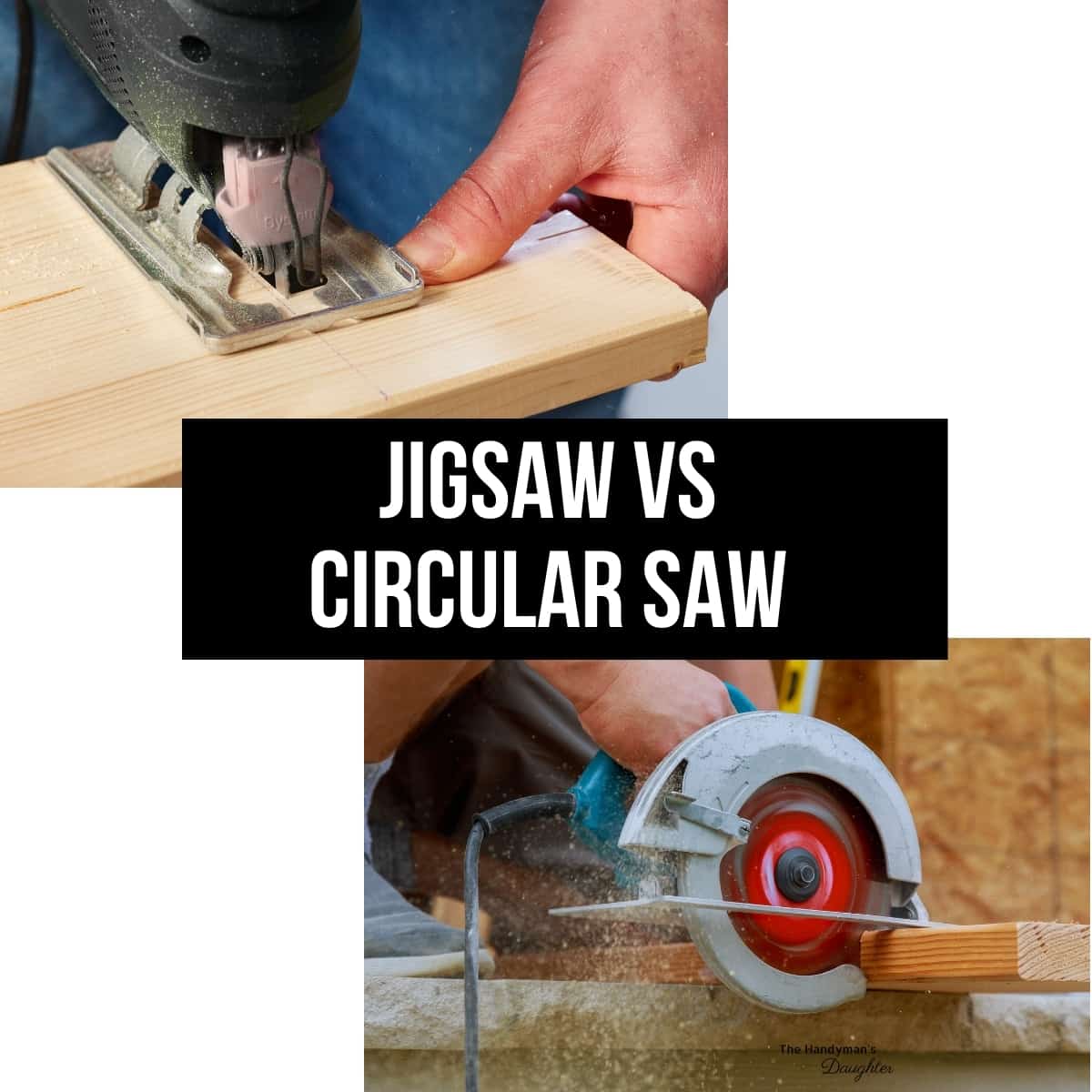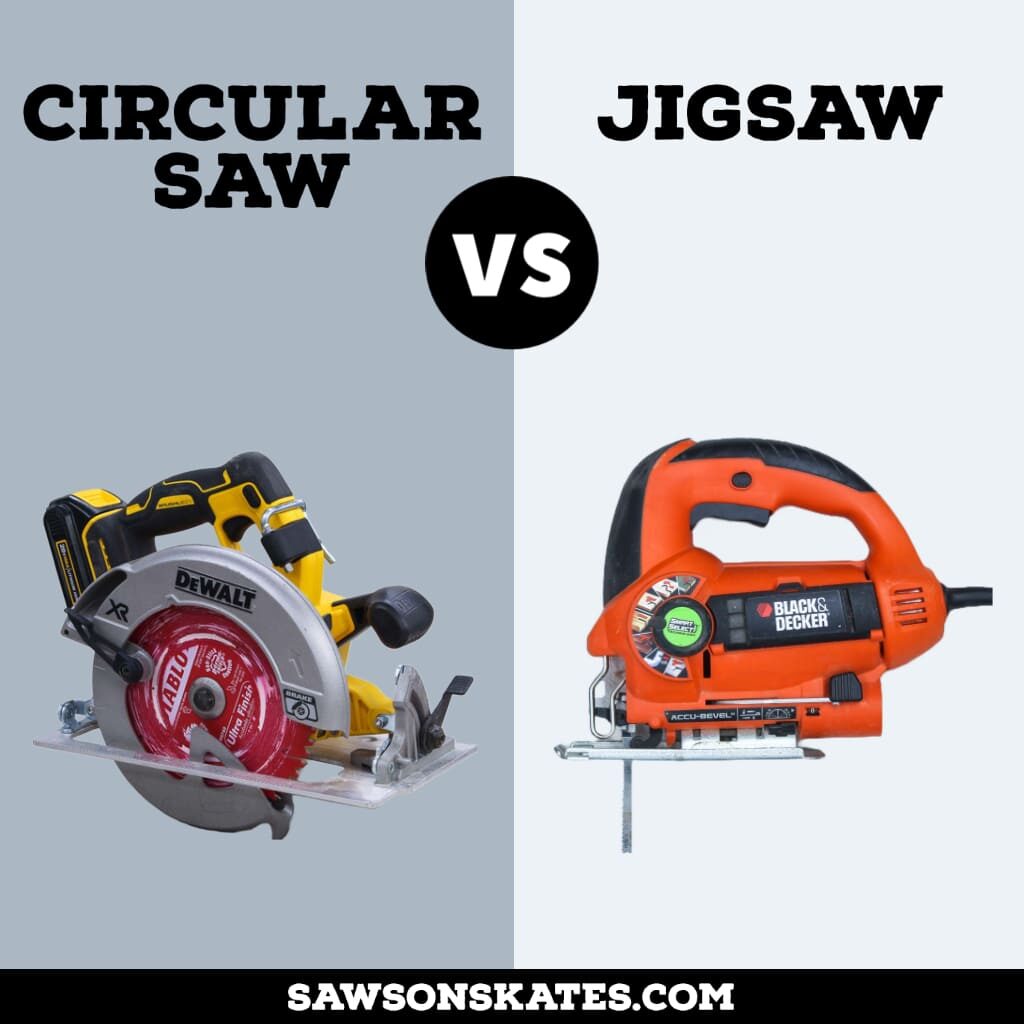Are you wondering which is better, a jigsaw or a circular saw? Well, you’ve come to the right place! Let’s dive into the world of power tools to discover the pros and cons of these two popular choices.
Now, imagine you have a woodworking project. You need a tool that can make precise curved cuts. That’s where a jigsaw shines! With its small, maneuverable blade, it can easily navigate tight corners and intricate designs.
On the other hand, if you’re tackling a project that requires long, straight cuts like building a bookshelf, a circular saw might be your best friend. Its powerful motor and large blade make cutting through thick materials a breeze. So, which will it be? Let’s find out!
When considering which tool to choose, it’s important to compare the features of a jigsaw and a circular saw. Here are 5 key features to consider:
1. Blade versatility: A jigsaw offers more flexibility with cutting different shapes and curves, while a circular saw is better for straight cuts.
2. Cutting depth: Circular saws have a greater cutting depth, making them suitable for thicker materials.
3. Speed and power: Circular saws are generally more powerful and faster for cutting through tough materials.
4. Portability: Jigsaws are lighter and easier to maneuver, making them great for intricate cuts in smaller spaces.
5. Precision: Jigsaws provide better precision and control for detailed work.
Consider your specific needs and projects to determine which tool would be better suited for you.

Which is Better: Jigsaw or Circular Saw?
Jigsaw and circular saws are two popular power tools used by both professionals and DIY enthusiasts for cutting various materials. While both tools serve similar purposes, they have distinct features and applications that make them better suited for specific tasks. In this article, we will compare the jigsaw and circular saw to determine which one is better based on different factors such as versatility, cutting capacity, precision, and ease of use. Whether you are a professional woodworker or a hobbyist looking to expand your tool collection, this comprehensive guide will help you make an informed decision.
Comparing Versatility
One of the primary factors to consider when choosing between a jigsaw and a circular saw is their versatility. A jigsaw is known for its ability to make intricate curved and scroll cuts, making it ideal for projects that involve cutting shapes and patterns in a variety of materials such as wood, plastic, and metal. The slender blade of a jigsaw allows for maneuverability and precise cutting, even in tight corners.
On the other hand, a circular saw is better suited for making straight, long cuts in materials like wood and plywood. Its powerful motor and large blade diameter enable it to slice through thick materials with ease. Circular saws are commonly used in carpentry and construction projects that involve framing, cutting large boards, or making long rip cuts. However, they lack the maneuverability and versatility of a jigsaw when it comes to intricate cuts and detailed work.
In terms of versatility, the jigsaw takes the lead with its ability to handle a wider range of cutting tasks.
Benefits of a Jigsaw
When it comes to the benefits of using a jigsaw, there are several advantages that make it a valuable addition to any toolbox:
- Ability to make intricate curved and scroll cuts
- Maneuverability in tight corners and difficult angles
- Suitable for cutting various materials, including wood, metal, and plastic
- Can create custom shapes and patterns
- Easy blade change for different cutting tasks
| Jigsaw | Circular Saw |
|---|---|
| Ability to make intricate curved and scroll cuts | Best for making straight, long cuts |
| Maneuverability in tight corners and difficult angles | Not as maneuverable in tight spaces |
| Suitable for cutting various materials, including wood, metal, and plastic | Primarily used for cutting wood and plywood |
| Can create custom shapes and patterns | Not suitable for intricate cuts or detailed work |
| Easy blade change for different cutting tasks | Blade change can be more time-consuming |
Overall, both the jigsaw and circular saw have unique benefits that make them suitable for specific cutting tasks. Understanding these differences will help you choose the right tool for your project.
Jigsaw vs Circular Saw: Ease of Use
Another important aspect to consider when deciding between a jigsaw and a circular saw is the ease of use. Both tools have their own learning curves and require proper technique and safety precautions to operate effectively.
A jigsaw is generally easier to handle, particularly for beginners, due to its lightweight and maneuverable nature. Its smaller blade allows for more control and precision, making it easier to follow curved or intricate cutting lines. The jigsaw’s adjustable speed settings also provide added flexibility, allowing users to match the cutting speed to the material being cut.
On the other hand, a circular saw can be more challenging to use, especially for those who are new to power tools. The larger blade and powerful motor make it more intimidating, but with practice and proper technique, it can deliver precise and accurate cuts. However, the lack of maneuverability and the need for a stable cutting surface may pose challenges in certain situations.
Tips for Using a Jigsaw
Here are some tips to ensure optimal performance when using a jigsaw:
- Use a sharp blade suitable for the material being cut.
- Secure the workpiece firmly to prevent vibrations and ensure accurate cuts.
- When making a curved cut, start with a pilot hole or an entry cut before following the desired pattern.
- Take breaks and allow the motor to cool down if using the jigsaw for an extended period.
- Wear safety goggles and ear protection for added safety.
By following these tips, you can make the most of your jigsaw and achieve impressive results.
Circular Saw vs Jigsaw: Cutting Capacity
When it comes to cutting capacity, the circular saw has the upper hand. Its powerful motor and larger blade diameter allow it to handle thicker materials with ease. Circular saws are commonly used for ripping boards, cutting large sheets of plywood, and other tasks that require long, straight cuts.
On the other hand, while jigsaws excel at intricate and curved cuts, their cutting capacity is limited when it comes to thicker materials. Their smaller blades and lower power make them less suitable for heavy-duty cutting tasks. Attempting to cut thick materials with a jigsaw may result in slower cutting speeds, rough edges, or even blade damage.
It is important to consider the cutting capacity required for your projects when deciding between a jigsaw and a circular saw.
Benefits of a Circular Saw
There are several advantages of using a circular saw for your cutting needs:
- Ability to cut through thicker materials with ease
- Ideal for making long, straight cuts
- Powerful motor for efficient cutting
- Can be used with a guide rail for added precision
- Great for construction and carpentry projects
Understanding the benefits and limitations of each tool will help you determine which one is better suited to your specific cutting requirements.
Jigsaw vs Circular Saw: Which Should You Choose?
Deciding between a jigsaw and a circular saw ultimately depends on the nature of your projects and the type of cuts you need to make. If you primarily work on intricate designs, curves, or scrollwork, a jigsaw is the better choice. Its versatility, maneuverability, and ability to make detailed cuts make it an invaluable tool for artists, woodworkers, and craft enthusiasts.
On the other hand, if your projects involve mostly straight cuts, long rip cuts, or working with thicker materials, a circular saw is the more practical option. Its power, cutting capacity, and efficiency make it well-suited for construction, carpentry, and larger-scale woodworking projects.
Remember, it’s always beneficial to have both tools in your collection if your budget allows, as they complement each other and offer a wider range of capabilities. However, if you can only choose one, consider the type of work you will be doing most frequently to make the best decision.
In conclusion, both jigsaws and circular saws are versatile tools that excel in different cutting applications. Whether you choose the jigsaw for its maneuverability and intricate cutting abilities or the circular saw for its power and cutting capacity, both tools have their own unique advantages. By understanding their strengths and limitations, you can make an informed decision and equip yourself with the right tool for the job.
Key Takeaways: Which is Better – Jigsaw or Circular Saw?
- Both jigsaw and circular saw have their unique advantages and best suited for different tasks.
- Jigsaw is great for making intricate cuts and curves, while circular saw is ideal for straight cuts and ripping lumber.
- Jigsaw is more portable and maneuverable, making it suitable for smaller projects or working in tight spaces.
- Circular saw provides more power and cutting depth, making it better for large-scale projects or working with thicker materials.
- Consider the specific requirements of your project and the type of cuts you need to make before deciding which saw is better for you.
Frequently Asked Questions
When it comes to choosing between a jigsaw and a circular saw, it’s important to understand their differences and their specific uses. Below, we’ve answered some common questions to help you determine which tool is better suited to your needs.
1. What are the main differences between a jigsaw and a circular saw?
While both tools are used for cutting wood, they have distinct differences. A jigsaw is a versatile tool that can make intricate cuts, such as curves and angles. It has a narrow blade that moves up and down, allowing for more precise cuts. On the other hand, a circular saw is designed for straight cuts and can handle thicker pieces of wood. It has a circular blade that spins rapidly to make quick, clean cuts.
Ultimately, the main difference lies in the type of cuts you need to make. If you require more intricate and detailed cuts, a jigsaw is the better choice. If you primarily need to make straight cuts in thicker materials, a circular saw is the way to go.
2. Which tool is easier to use for beginners?
For beginners, a jigsaw is generally easier to use. Its smaller size and maneuverability make it easier to control, especially when making curved or detailed cuts. Additionally, jigsaws have adjustable speed settings, allowing beginners to start at a slower speed and gradually increase as they gain confidence and skill.
Circular saws, on the other hand, require a bit more practice and skill to ensure straight and accurate cuts. They are larger and can be more intimidating for beginners. However, with practice and proper technique, both tools can be mastered by beginners.
3. Which tool is more versatile?
When it comes to versatility, the jigsaw takes the crown. Its ability to make intricate cuts in various shapes and angles makes it the go-to tool for projects that require creativity and precision. Whether you’re cutting curves, making cutouts, or creating detailed designs, a jigsaw can handle it all.
A circular saw, on the other hand, is primarily designed for straight cuts. While it can be used for other applications, its true power lies in its ability to make long, straight cuts effortlessly. So, if versatility is your priority, the jigsaw is the better option.
4. Which tool is better for cutting curves?
When it comes to cutting curves, the jigsaw is the clear winner. Its narrow blade and the ability to move in different directions allow for smooth and precise curved cuts. Whether you’re working on a DIY project or creating intricate designs, the jigsaw can handle curves with ease.
Circular saws, on the other hand, are more suitable for straight cuts and are not designed for cutting curves. Attempting to cut curves with a circular saw would require a lot of skill, experience, and potentially other tools to achieve the desired results.
5. Which tool is more accurate?
Both jigsaws and circular saws can be accurate, but it depends on the type of cut you’re making and your skill level. In general, if you need to make intricate cuts or follow a specific pattern, a jigsaw would be the more accurate tool. Its narrow blade and maneuverability allow for greater precision.
On the other hand, if you’re looking for quick and precise straight cuts, a circular saw can also provide accuracy when used with the right techniques and guides. Using a straight edge or a guide can greatly enhance the accuracy of a circular saw.

Summary
So, which is better: the jigsaw or the circular saw? Well, it depends on what you need to do.
If you want to make intricate cuts in various materials, like curves or patterns, the jigsaw is your best bet. But if you need to make long, straight cuts quickly and efficiently, the circular saw is the way to go. Both tools have their strengths and weaknesses, so choose based on your specific needs and preferences.
